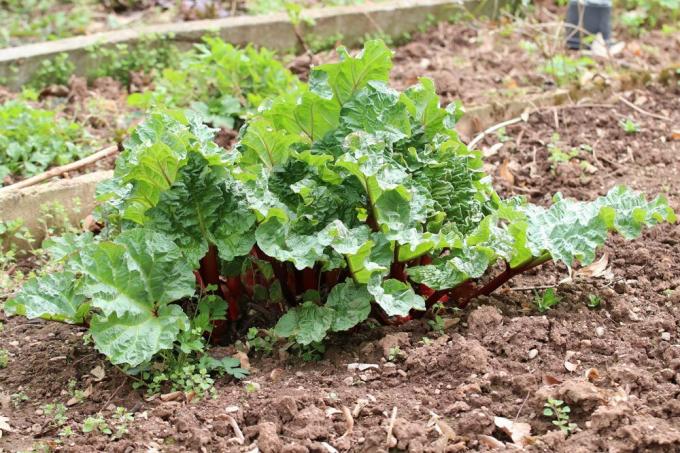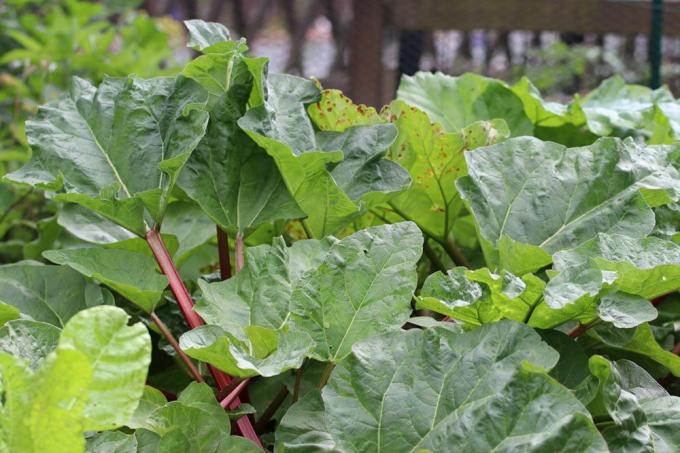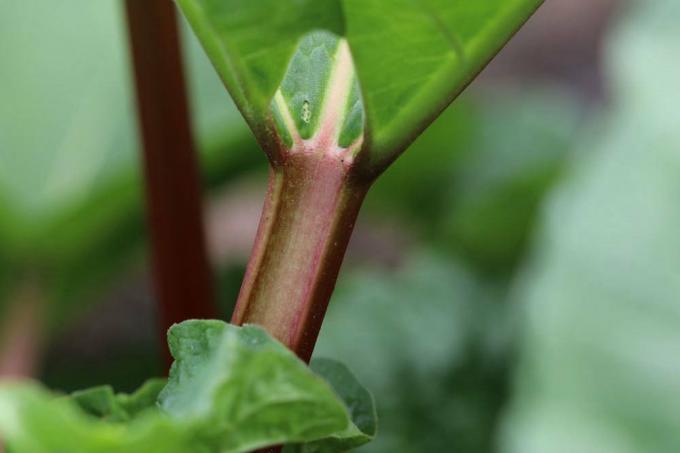
table of contents
- Transplant rhubarb
- time
- Correct choice of location
- Share perennials correctly
- Transplanting rhubarb: instructions
- No harvest in the first year
rhubarb (Rheum barbarum) is very popular in this country. It is often used in cakes and as a compote. From a botanical point of view, rhubarb belongs to vegetables and perennials. In general, the knotweed plant is very robust and easy to care for. The rhubarb has a lifespan of 10 to 15 years. During this time it is advisable to transplant the pole vegetables after a few years.
Transplant rhubarb
Transplant every seven years
Rhubarb is a heavy eater. It constantly needs large amounts of nutrients, so it also quickly depletes the soil. For this reason, the perennial should be transplanted after a few years. Opinions are now divided here; it is recommended to change the location after seven to ten years, always depending on the composition of the earth. After this time, not only is the soil completely drained, but the rhubarb has also grown in volume. The implementation has various advantages:
- at the same time an increase can take place
- the perennial is generally rejuvenated
- the plant remains strong and a good harvest in the following years is guaranteed
- the soil can now regenerate itself with a different crop rotation

Nutrient deficits in the soil are mainly expressed in a lower harvest. In an average garden soil, the nutrient supply is usually depleted after seven years. Then it's time to transplant. The nutrient content of the soil should therefore be checked from time to time. Special soil laboratories create a soil analysis for this purpose. The only thing that needs to be done is to remove the garden soil:
- Soil analysis costs from € 20
- Implementation every three to five years
- Time: early spring (start of the season) or in autumn after harvest
- Extraction from soil depths of 0 to 90 cm from various areas of the garden
- Mix soil
- Put 500 g mixing soil in a plastic bag into the laboratory
- Investigations are carried out with regard to the composition of the soil, nutrient content and pH value
- in addition, receipt of fertilizer recommendations
tip: The sour stick vegetables are very healthy due to their content of vitamins and minerals. In addition, it has few calories. However, it can only be enjoyed cooked as it contains oxalic acid. If consumed in excess, this is poisonous in its raw state.
time
The best time to turn rhubarb is autumn, from September to October. Because at this time the soil is still relatively warm and the plant can still grow well before the start of winter. Now the rhubarb is also taking a break, then it is barely visible on the bed. Alternatively, they can be transplanted in spring, preferably shortly before budding.
Correct choice of location
Before each transplant, the new location must be carefully selected so that the rhubarb can then can also grow well again and can expect a rich harvest in the following years is. A few points must be observed:
- Sun to partial shade
- warm and sheltered place
- as deep-rooters, a deep, nutrient-rich soil
- moist, well drained substrate
- no waterlogging
- optimally high proportion of clay and sand
- slightly acidic pH between 5 and 6
- Place it on the edge of the bed
In any case, rhubarb must not be moved to a place where it was already five years ago. Here the earth has not yet recovered sufficiently. A shady location is also only tolerated to a limited extent. The harvest there is very sparse. Only short poles appear, but oversized leaves.

tip: You can determine the pH of the soil yourself. No chemical knowledge is required for this. The test can be carried out using a pH soil test from a specialist store or hardware store or with indicator strips. Both work via a coloring reaction.
Share perennials correctly
After the rhubarb tree has been dug up, it can also be used for propagation. All you have to do is divide it into several pieces. It is best to proceed as follows:
- best time to divide when the first leaves turn yellow
- Cut into pieces with a sharp spade after digging up
- Pieces should not weigh more than 1 kg
- each piece must have at least one bud, preferably two to three
- Buds must not have sprouted
- Allow cut surfaces to dry off before replanting, otherwise risk of rot
If the shrub splits too early, the plant will not have enough time to properly grow before the start of winter, as it needs a lot of strength for this.
Transplanting rhubarb: instructions
When it is time to move rhubarb, it must be done with foresight and care, as it will spend several years in the new location. Below are the step by step instructions for transplanting:
- first dig the soil 70 cm deep
- remove all weeds
- Soil must be loose
- Dig the planting hole before digging up the plant
- Perennials should not stay in the air longer than necessary
- The planting hole must be twice the size of the root ball
- Work in garden soil, compost and horn shavings dug into the planting hole
- Insert drainage made of gravel, chippings or potsherds at the bottom of the pit
- now dig up rhubarb extensively
- remove old leaves
- If necessary, divide into 1 kg pieces with a sharp spade
- let the cut surfaces dry after dividing
- Place the perennial in the planting hole, the buds must be 3 to 5 cm below the surface of the ground
- Carefully step down the soil after planting
- Water abundantly, then water regularly
- Avoid waterlogging
- Application of a thick layer of mulch from compost
An area of one square meter should always be planned for each plant. The planting distance to other perennials must be at least 1 to 1.5 m.
tip: Rhubarb grows particularly well near spinach, peas, kohlrabi, beans or lettuce.
No harvest in the first year
Every change of location is associated with stress for the rhubarb. He then needs one Settling-in periodwhere it can get used to the new place and consequently grow properly. Therefore, it is recommended that there should be no harvest in the first year after implementation, only in the second year after that. Here then only limited to a few weeks from April to May. In the following year, the rhubarb will thank you for this "break" to relax with a rich harvest.
tip: Traditionally, the harvest takes place from April to St. June. After that, you should not harvest any more, as more oxalic acid is formed in the rhubarb. In high doses, this can lead to kidney damage, stomach upset, vomiting and circulatory problems.



